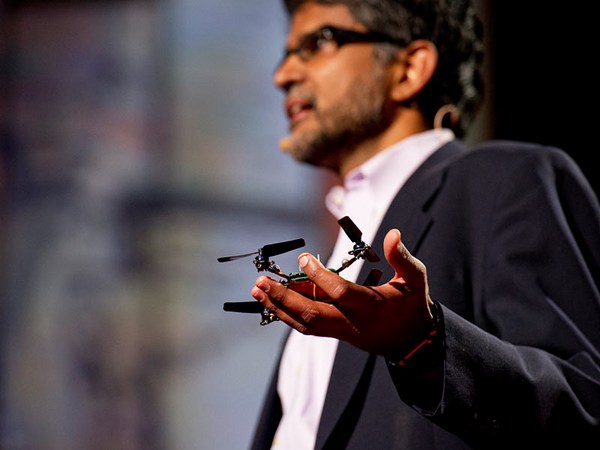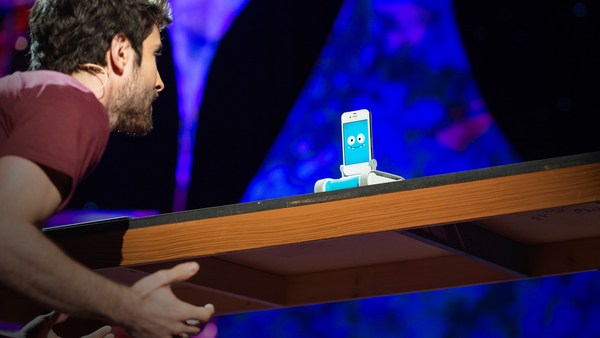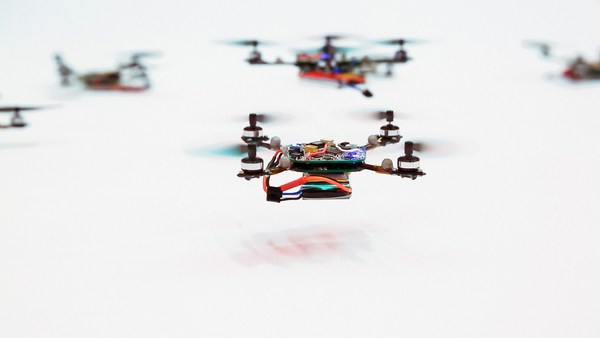So, let’s get started. When I think about superpowers, I usually think about superheroes. So, in this list of superheroes, Ant-Man is particularly interesting to me. Sometimes he expands into a very large scale, and sometimes he shrinks down into a tiny scale. So, how about if you think about robotics from the perspective of scaling? Now, if I talk about robots to people, most often people think about larger-scale robots: legged robots, humanoid robots, or even trains or airplanes. On the other end of the spectrum, you can make very tiny robots, made of the MEMS technology. What I want to talk about today is focusing on insect-scale robots, robots that range from one to five centimetres and weigh from 10 milligrammes to 10 grams. As a very quick example, when I was a student at Harvard, I worked on a project called the RoBoBee. And the idea is to create a robot that has similar size and functions as bees in nature. So, very quickly I want to address several questions together. First, why do we study microrobotics? Well, to me, there are two reasons. One: By leveraging interesting physics at the centimetre scale, we can enable multiple functions in a single robot. So, in this case, we’re teaching the same robot to be able to both fly and swim. And more than that, you can use a microscale robot as a platform to investigate interesting physics at the centimetre scale. By looking at the flow field that’s generated by a flapping-wing robot, we can infer about the lift and drag generation mechanism of flying insects. Second question: What makes microrobots unique? The short answer is that at this scale, inertia becomes less important and new properties arise. For example, you can drop a microrobot from very high above and you see a very small amount of changes to its performance. And more than that, you can play with surface effects. In this case, we are trying to teach the same microscale robot to be able to work on land, leverage surface tension forces so it can swim on the surface of water, but also, it can change the surface tension forces so it can sink underwater when it wants to. So, now I recommend you pay attention to a side video - a side view of that video. The robot completely submerged underwater and then it will climb an incline to return back onto land. I would argue that this is, again, very challenging, if not impossible, for a larger-scale robot, again, just by thinking about surface forces. And also, microrobots are fast. In the next video, we are going to use a microscale combustion that completes within one one-thousandths of a second. The robot will generate a very quick impulse so that it can jump off the surface of water and fly. So, the next question is, what are potential applications of microrobots? Well, in the short term, I can think about a lot of them. I can strap a tiny camera on top of this legged robot and teach this robot to climb inside of a turbine engine and look for cracks. In the longer term, we are thinking about using a large number of microrobots and deploy them in realistic situations. So far, all of the microrobots I’ve shown you are highly agile and resilient. However, you know, we still face key challenges in sensing, control and power autonomy. But what I also want to say is, a lot of microrobots are really working in solo. We are also trying to address key challenges in making a lot of them and allowing them to robustly interact with the environment. So, we look into another field for inspiration, which is soft robotics. For quite some time now, people know how to make soft robots robustly and scale - and in a very scalable manner. And we have new tools for controlling and powering the soft robot. But soft robots have their own challenges. Most soft robots are slow, and their actuation is not as precise as rigid robots, so that their functionalities are limited. So, in our lab, we aim to address key challenges in both fields by looking at a new direction, which is microscale robots powered by soft artificial muscles. So, let me show you how it works. Here we incorporate a microscale soft actuator in a flapping-wing robot. And as you can see, this actuator is elongating and contracting to drive a pair of flapping wings. And this actuator operates at up to 500Hz. And, for the first time, we are able to demonstrate that a soft driven robot is able to lift off. And you can see the soft actuator again is elongating and contracting, just like real muscles. Now, to demonstrate the flight capability of soft actuator robots, we put four of those units together. Our lab specializes in designing, not only building the robot, also creating the flight controllers. So now I’m showing you a real-time flight performed by this robot. It flies so stably that it feels like this robot is just staying at a particular setpoint. All right. So, soft robots can fly. But the key answer I want to get to today is, what is its superpower? The thing - the first thing that comes to mind is, well, soft robots are robust. So, while it’s flying, I can try to push down the robot and hopefully the robot can recover to the hovering setpoint. Now, this is not very impressive. Larger robots can do that as well. But what I think starts to become interesting is that I start to hit the actuators or even the wings of the robot. Imagine hitting the propellers of a quadrotor. That’s not going to be turned very well. And in fact, I can hit the robot really hard. And in this case, the robot is hit so hard that it’s not going to be able to recover. But the robot simply bounces on the floor and then it will recover to the hovering setpoint. Very difficult for larger-scale robots, but very easy for insect- and small-scale robots. And in fact, we can push this one step further. How about trying to fly in very cluttered environments, trying to land on a cactus? How about cutting parts of the wing off or piercing the actuators with needles? We have come up with a new class of robust soft actuators. So even if the actuators are pierced or burned, or even if we cut out part of the wings, the robot can still hover. I would argue that this is a level of resilience that’s unachieved in existing rigid robots. And finally, robots are agile. In this case, we are trying to demonstrate this robot can perform a somersault. And in fact, this is so fast to be seen, so, we can play the same video in a slowed-down time. So again, due to the shrinking inertia, this robot can perform a somersault within 0.15 seconds. This is the fastest somersault that any aerial robot can do. Again, just as a consequence of shrinking down in scale. And finally, we are taking inspirations from nature. Fireflies are amazing animals. When they fly, they shine a light. So, we thought, let’s demonstrate similar functions in our small robot. We put electroluminescent particles in the soft actuator, so when they fly, they can also shine a light. So now we can just track the flight of our robots with a couple of iPhones. And what are we thinking about those robots in the future? One thing that we are trying to push for is to put tiny circuitry on board and tiny energy sources on board so hopefully one day those robots can fly outside of our labs. And my students are trying to command a lot of robots to fly together. So, we are exploring 3D printing techniques so we can make a lot of them more consistently. About a few months ago, my students have been able to fly two robots together, and now while they are flying, they’re collectively carrying a payload. Now, if you zoom into that video, you’re going to see that my students had so much fun that they put our lab name on it. So, we are the Soft and Micro Robotics Lab here in MIT. So, we are doing a lot of fun work in our lab. What do we do? We make bugs during the day, and we try to remove them during late nights. (Laughter) All I’m trying to say is, we both build the robots and we ride the flight controllers. I would argue that the next 10 to 15 years is going to be very exciting for people who work on the field of microrobotics. Thank you. (Applause)





